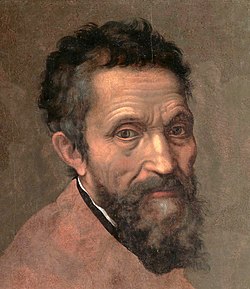Michelangelo Buonarroti Quote
But if it so happens ... a work ... under pain of otherwise becoming shameful or false, requires fantasy ... [and that] certain limbs or elements of a figure are altered by borrowing from other species, for example transforming into a dolphin the hinder end of a griffon or a stag ... these alterations will be excellent and the substitution, however unreal it may seem, deserves to be declared a fine invention in the genre of the monstrous.When a painter introduces into this kind of work of art chimerae and other imaginary beings in order to divert and entertain the senses and also to captivate the eyes of mortals who long to see unclassified and impossible things, he shows himself more respectful of reason than if he produced the usual figures of men or of animals.
But if it so happens ... a work ... under pain of otherwise becoming shameful or false, requires fantasy ... [and that] certain limbs or elements of a figure are altered by borrowing from other species, for example transforming into a dolphin the hinder end of a griffon or a stag ... these alterations will be excellent and the substitution, however unreal it may seem, deserves to be declared a fine invention in the genre of the monstrous.When a painter introduces into this kind of work of art chimerae and other imaginary beings in order to divert and entertain the senses and also to captivate the eyes of mortals who long to see unclassified and impossible things, he shows himself more respectful of reason than if he produced the usual figures of men or of animals.
Related Quotes
About Michelangelo Buonarroti
Michelangelo achieved fame early. Two of his best-known works, the Pietà and David, were sculpted before the age of 30. Although he did not consider himself a painter, Michelangelo created two of the most influential frescoes in the history of Western art: the scenes from Genesis on the ceiling of the Sistine Chapel in Rome, and The Last Judgment on its altar wall. His design of the Laurentian Library pioneered Mannerist architecture. At the age of 71, he succeeded Antonio da Sangallo the Younger as the architect of St. Peter's Basilica. Michelangelo transformed the plan so that the Western end was finished to his design, as was the dome, with some modification, after his death.
Michelangelo was the first Western artist whose biography was published while he was alive. Three biographies were published during his lifetime. One of them, by Giorgio Vasari, proposed that Michelangelo's work transcended that of any artist living or dead, and was "supreme in not one art alone but in all three".
In his lifetime, Michelangelo was often called Il Divino ("the divine one"). His contemporaries admired his terribilità—his ability to instill a sense of awe in viewers of his art. Attempts by subsequent artists to imitate the expressive physicality of Michelangelo's style contributed to the rise of Mannerism, a short-lived movement in Western art between the High Renaissance and the Baroque.
